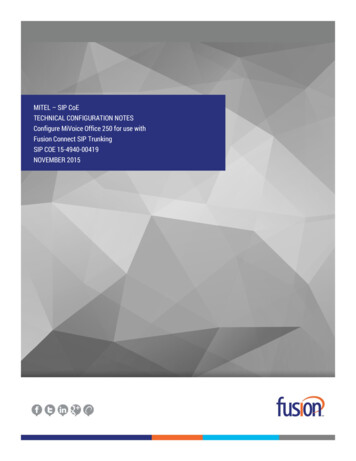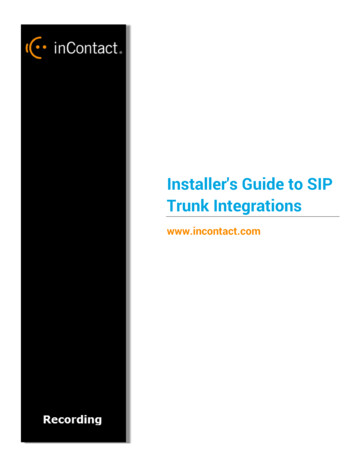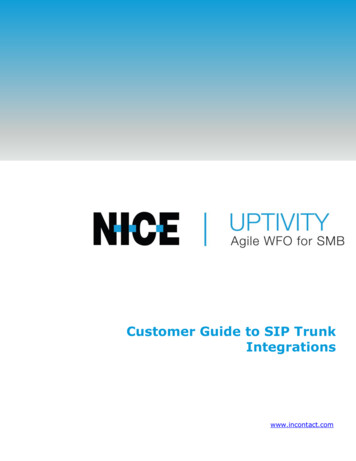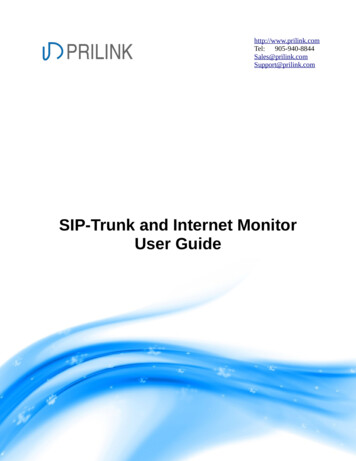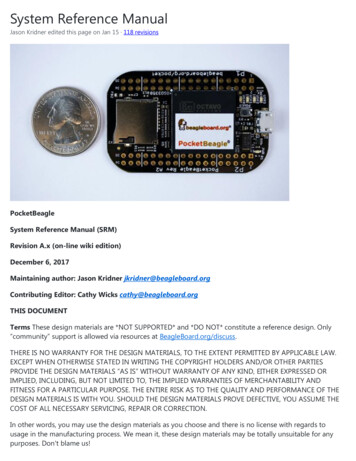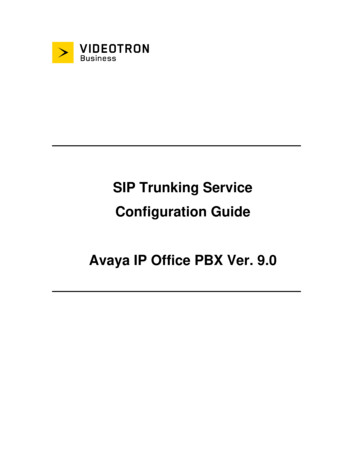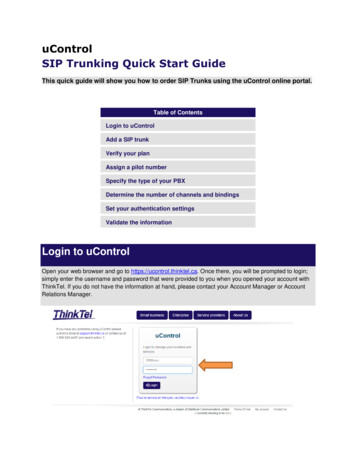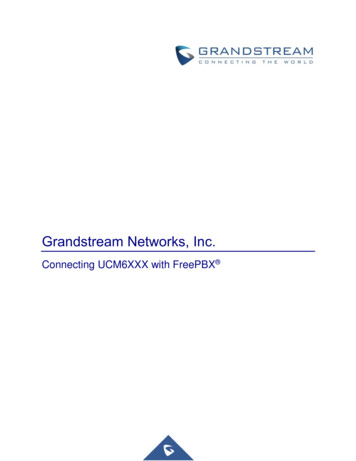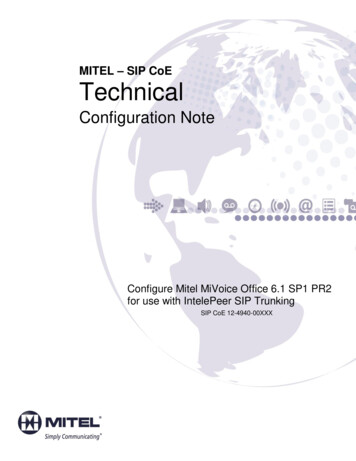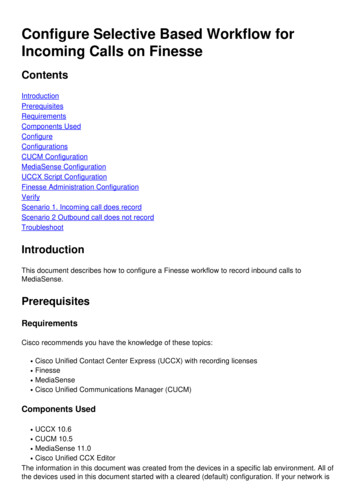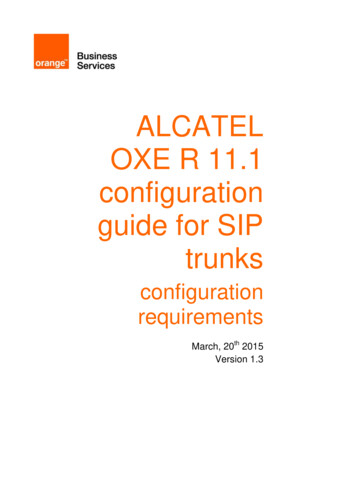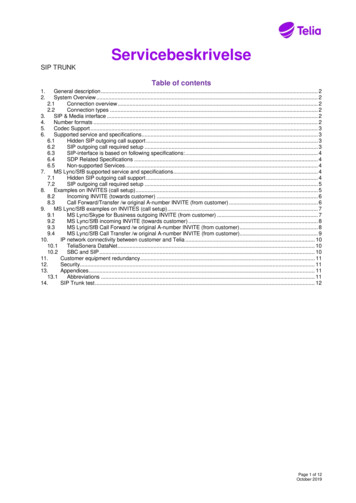
Transcription
ServicebeskrivelseSIP TRUNKTable of contents1.2.General description . 2System Overview . 22.1Connection overview . 22.2Connection types . 23.SIP & Media interface . 24.Number formats . 25.Codec Support . 36.Supported service and specifications . 36.1Hidden SIP outgoing call support . 36.2SIP outgoing call required setup . 36.3SIP-interface is based on following specifications: . 46.4SDP Related Specifications . 46.5Non-supported Services . 47.MS Lync/SfB supported service and specifications. 47.1Hidden SIP outgoing call support . 47.2SIP outgoing call required setup . 58.Examples on INVITES (call setup) . 58.2Incoming INVITE (towards customer) . 68.3Call Forward/Transfer /w original A-number INVITE (from customer) . 69.MS Lync/SfB examples on INVITES (call setup). 79.1MS Lync/Skype for Business outgoing INVITE (from customer) . 79.2MS Lync/SfB incoming INVITE (towards customer) . 89.3MS Lync/SfB Call Forward /w original A-number INVITE (from customer) . 89.4MS Lync/SfB Call Transfer /w original A-number INVITE (from customer). 910.IP network connectivity between customer and Telia . 1010.1TeliaSonera DataNet . 1010.2SBC and SIP . 1011.Customer equipment redundancy. 1112.Security. 1113.Appendices . 1113.1Abbreviations . 1114.SIP Trunk test . 12Page 1 of 12October 2019
1. General descriptionTelia SIP Trunk is a voice product enabling connection of an IP PBX system to the public telephony network over anIP data connection. The company does not need to purchase and maintain separate ISDN lines for voice communication and data access for data.Telia SIP Trunk offers high availability and quality of service by using carrier grade border control, media gateway andIP PBX equipment.Capacity variants for Telia SIP Trunk are 10, 20, 30, 40, 60, 80, 100, 120, 150, 200, 300, 600 or 800 concurrent calls.2. System Overview2.1 Connection overview2.2 Connection typesThe above solutions describe the two possible scenarios at the customer premises:1. Combination of customer equipment and TeliaSonera DataNet router for a combined data and voice solution.2. Voice only solution with TeliaSonera DataNet router.3. SIP & Media interfaceUDP port 5060 is used for SIP signalling by default for both parties.TCP port 5060 is used for MS Lync/SfB for both parties.Used range for RTP ports is by default 16384-32767.One IP-address for both SIP signalling and RTP to and from Telia.4. Number formatsAll numbers, i.e. From, To and P-Asserted-Identity as well as Diversion, History-Info and Referred-By, must complywith international (E.164) format for interconnect according to table below.Page 2 of 12October 2019
Where CC is Country Code and abcdefgh is Subscriber Number according to E.164 standard. i.e. 4588313131 is aDanish 8 digit number.SIP From (A-Number)SIP To (B-Number)SIP: CCabcdefghSIP: CCabcdefghSIP P-Asserted-Identity(Generic-Number)SIP: CCabcdefghSIP Diversion/History-Info /Referred-By(Redirecting-Number)SIP: CCabcdefghIt is by default required that P-Asserted-Identity (except MS Lync/SfB) always be present in any outgoing call,representing the correct DDI-number belonging to the customer/user.In case of Call Forward/Transfer it is required that Diversion Header (HistoryInfo/Referred-By for MSLync/SfB) is present and representing the correct redirecting DDI-number belonging to the customer/user.Contact Header and Request Line must also comply with international (E.164) number format.5. Codec SupportSupported voice codec is currently G.711 a/ulaw (default is alaw).Supported fax protocol is G.711 Pass-Through. (T.38 can be requested if needed) RFC4733 is recommended toDTMF transmission (payload 101).It is the responsibility of the customer, to confirm that the customer equipment (e.g. PBX/SBC/Gateway) supports theabove codecs.6. Supported service and specifications Calling Line Identity Presentation (CLIP)Calling Line Identity Restriction (CLIR).Call Hold (HOLD)P-Asserted-Identity and Diversion Header6.1 Hidden SIP outgoing call supportHidden/anonymous outgoing call is supported by either uri-user "anonymous" in the From and P-Asserted Header oruse of Privacy Header.e.g.From: sip:anonymous@[anonymous.dk or your ip-address] P-Asserted-Identity: sip:anonymous@[anonymous.dk or your ip-address] orFrom: sip: CCabcdefgh@[yourdomain.dk or your ip-address] P-Asserted-Identity: sip: CCabcdefgh@[yourdomain.dk or your ip-address]Privacy: idFor use of hidden number in Diversion Header, please use parameter privacy.e.g. Diversion: tel: CCabcdefgh ;privacy full;reason unconditional;counter 16.2 SIP outgoing call required setupAll outgoing calls are by default required to have the following parameters as a minimum in SIP Header: From (this will be the number presented to receiver) To P-Asserted-Identity (this will be the number used for billing purpose)The number in From Header should represent a DDI-number of the customer/user when making normal outgoingcalls.P-Asserted-Identity must always represent a correct DDI-number of the customer/user.NOTE! In case P-Asserted-Identity cannot be provided by customer, all billing will be done on the "main number" assigned to the SIP Trunk.Page 3 of 12October 2019
In case of Call Forward/Transfer, Diversion Header is required to be present and must always represent a correctredirecting DDI-number of the customer/user. Diversion (this will then be the number used for billing purpose)Then the number in From and P-Asserted-Identity Header can represent the original A-number instead (calling in).If using 302-message for Call Forward, the number in Contact information must be in international (E.164) format asthe rest of the numbers are.6.3 SIP-interface is based on following specifications: RFC 2806, URLs for telephone calls RFC 2976, The SIP INFO Method RFC 3261, SIP: Session Initiation Protocol RFC 3262, Reliability of Provisional Responses in the Session Initiation Protocol (SIP) RFC 3311, The Session Initiation Protocol (SIP) UPDATE Method RFC 3312, Resource management and SIP RFC 3323, A privacy mechanism for the session initiation protocol (SIP) RFC 3325, Private extensions for SIP within trusted networks RFC 3326, The Reason Header Field for the Session Initiation RFC 3389, Real-time Transport Protocol (RTP) Payload for Comfort Noise (CN) RFC 3398, Integrated Services Digital Network (ISDN) User Part (ISUP) to Session Initiation Protocol (SIP) Mapping RFC 3550, RTP: A Transport Protocol for Real-Time Applications. RFC 3551, RTP Profile for Audio and Video Conferences with Minimal Control. RFC 3578, Mapping of Integrated Services Digital Network (ISDN) RFC 3966, The tel URI for Telephone Numbers RFC 4028, Session Timers in the Session Initiation Protocol (SIP) RFC 4733, RTP Payload for DTMF Digits, Telephony Tones, and Telephony Signals RFC 4734, Definition of Events for Modem, Fax, and Text Telephony Signals RFC 5806, Diversion Indication in SIP draft-levy-sip-diversion-056.4 SDP Related Specifications RFC 3264, Offer/Answer Model with the Session Description Protocol RFC 2327, SDP: Session Description Protocol RFC 4733, RTP Payload for DTMF Digits, Telephony Tones and Telephony Signals6.5 Non-supported ServicesSystems using SIP Method REFER for i.e. Call Transfer feature are not compatible. Using REFER could lead to uncontrolled charging scenarios and therefore is not supported.SIP registration is not supported. Registration of users should be done on customer’s registrar device.7. MS Lync/SfB supported service and specifications Calling Line Identity Presentation (CLIP)Calling Line Identity Restriction (CLIR).Call Hold (HOLD)History-Info/Referred-By Header (when Call Forward/Transfer)IMPORTANT: Setup MS Lync/SfB to use TCP port 5060 (not 5068)7.1 Hidden SIP outgoing call supportHidden/anonymous outgoing call is supported by either uri-user "anonymous" in the From Header or use of PrivacyHeader.e.g.From: sip:anonymous@[anonymous.dk or your ip-address] orFrom: sip: CCabcdefgh@[yourdomain.dk or your ip-address] Page 4 of 12October 2019
Privacy: idFor use of hidden number in History-Info or Referred-By Header, this is not necessary since it is by default made byTelia.7.2 SIP outgoing call required setupAll outgoing calls are by default required to have the following parameters as a minimum in SIP Header: From (number presented to receiver and used for billing)ToThe number in From Header should represent a DDI-number of the customer/user when making normal outgoingcalls.In case of Call Forward/Transfer, History-Info/Referred-By Header is required to be present and must always represent a correct redirecting DDI-number of the customer/user. History-Info/Referred-By (this will then be the number used for billing purpose)Then the number in From Header can represent the original A-number instead (calling in).8. Examples on INVITES (call setup)The yellow marked uri-host represents the IP-address to and from Telia and the green marked uri-host represents theIP-address (or Domain name) of the customer equipment.8.1 Outgoing INVITE (from customer)This is an example of how a typical INVITE would look like, when customer is making a call. It is very important thatthe parameter uri-host is set correctly, otherwise it will/can result in calls being rejected or failing.SIPSBCPSTN/ISDNINVITE INVITE ISUP SETUP-------------------- ------------------ -------------------- outgoing callFrom: 4588271340 From: 4588271340 A-nb: 88271342To: 4588313131 To: 4588313131 B-nb: 88313131PAI: 4588271342 PAI: 4588271342 Gen: 88271340SIPRequest LineINVITE sip: 4588313131@194.255.250.108 SIP/2.0HeadersVia: SIP/2.0/UDP 192.168.0.1:5060;branch z9hG4bK AI2014Sep05122549 4549212970133To: sip: 4588313131@194.255.250.108 From: sip: 4588271340@192.168.0.1 ;tag AI8F99938EE8DFEA5CCall-ID: AIF3EE329324D41881@192.168.0.1CSeq: 1 INVITEMax-Forwards: 70Contact: sip: 4588271340@192.168.0.1:5060 Accept: application/sdpAllow: age 5 of 12October 2019
Allow-Events: presence,dialog,message-summaryPrivacy: noneSupported: 100relP-Asserted-Identity: sip: 4588271342@192.168.0.1;user phone Content-Type: application/sdpContent-Length: 245BodySDP PDUv 0o 1115359982 1115359982 IN IP4 192.168.0.1s callc IN IP4 192.168.0.1t 0 0m audio 5006 RTP/AVP 8 0 101a rtpmap:8 PCMA/8000a rtpmap:0 PCMU/8000a rtpmap:101 telephone-event/8000a fmtp:101 0-15a sendrecva ptime:208.2 Incoming INVITE (towards customer)This is an example of how a typical INVITE would look like, when customer is receiving a call.SIPSBCPSTN/ISDNINVITE INVITE ISUP SETUP --------------------- -------------------- -------------------- incoming callFrom: 4588313131 From: 4588313131 A-nb: 88313131To: 4588271340 To: 4588271340 B-nb: 88271340SIPRequest LineINVITE sip: 4588271340@192.168.0.1:5064;user phone SIP/2.0HeadersVia: SIP/2.0/UDP 194.255.250.108:5060;branch z9hG4bKuptjnb2038dh335ni080.1To: sip: 4588271340@192.168.0.1;user phone From: sip: 4588313131@194.255.250.108 ;tag 1l3aamContact: sip: 4588313131@194.255.250.108:5060;transport udp Max-Forwards: 69Call-ID: ursrd1k-2407893958@osd3-ssw.dk.telia.netCSeq: 32176 INVITEAllow: d: 100relContent-Type: application/sdpContent-Length: 207BodySDP PDUv 0o - 106225578939588876 1 IN IP4 194.255.250.108s c IN IP4 194.255.250.108t 0 0a sendrecvm audio 17314 RTP/AVP 8 101a rtpmap:8 PCMA/8000a rtpmap:101 telephone-event/8000a fmtp:101 0-158.3 Call Forward/Transfer /w original A-number INVITE (from customer)This is an example of how a typical INVITE would look like, when Call Forward or Call Transfer is used and customerwant to have original A-number presented (also called ByPass or CLIPSA). In this example, the A-number is an International number.SIPSBCPSTN/ISDNINVITE INVITE ISUP SETUP ------------------- -------------------- -------------------- incoming callFrom: 464090510 From: 464090510 A-nb: 464090510To: 4588271340 To: 4588271340 B-nb: 88271340 Divert call Page 6 of 12October 2019
INVITE INVITE ISUP SETUP-------------------- -------------------- -------------------- outgoing callFrom: 464090510 From: 464090510 A-nb: 464090510To: 4526262626 To: 4526262626 B-nb: 26262626PAI: 464090510 PAI: 464090510 Gen: 464090510DIV: 4588271340 DIV: 4588271340 Redir: 88271340SIPRequest LineINVITE sip: 4526262626@194.255.250.108 SIP/2.0HeadersVia: SIP/2.0/UDP 192.168.0.1:5060;branch z9hG4bK AI2014Sep05122549 4549212970133To: sip: 4526262626@194.255.250.108 From: sip: 464090410@192.168.0.1 ;tag AI8F99938EE8DFEA5CCall-ID: AIF3EE329324D41881@192.168.0.1CSeq: 1 INVITEMax-Forwards: 70Contact: sip: 4588271340@192.168.0.1:5060 Accept: application/sdpAllow: llow-Events: presence,dialog,message-summaryPrivacy: noneSupported: 100relP-Asserted-Identity: sip: 4588271340@192.168.0.1;user phone Diversion: sip: 4588271340@192.168.0.1 ;counter 1;reason unconditional;privacy fullContent-Type: application/sdpContent-Length: 245BodySDP PDUv 0o 1115359982 1115359982 IN IP4 192.168.0.1s callc IN IP4 192.168.0.1t 0 0m audio 5006 RTP/AVP 8 0 101a rtpmap:8 PCMA/8000a rtpmap:0 PCMU/8000a rtpmap:101 telephone-event/8000a fmtp:101 0-15a sendrecva ptime:209. MS Lync/SfB examples on INVITES (call setup)The yellow marked uri-host represents the IP-address to and from Telia and the green marked uri-host represents theIP-address (or Domain name) of the customer equipment.9.1 MS Lync/Skype for Business outgoing INVITE (from customer)This is an example of how a typical INVITE would look like, when customer is making a call. It is very important thatthe parameter uri-host is set correctly, otherwise it will/can result in calls being rejected or failing.SIPSBCPSTN/ISDNINVITE INVITE ISUP SETUP-------------------- -------------------- -------------------- outgoing callFrom: 4588271340 From: 4588271340 A-nb: 88271340To: 4588313131 To: 4588313131 B-nb: 88313131SIPRequest LineINVITE sip: 4588313131@194.255.250.108 SIP/2.0HeadersVia: SIP/2.0/UDP 192.168.0.1:5060;branch z9hG4bK AI2014Sep05122549 4549212970133To: sip: 4588313131@194.255.250.108 From: sip: 4588271340@192.168.0.1 ;tag AI8F99938EE8DFEA5CCall-ID: AIF3EE329324D41881@192.168.0.1CSeq: 1 INVITEMax-Forwards: 70Contact: sip: 4588271340@192.168.0.1:5060 Accept: application/sdpAllow: age 7 of 12October 2019
Allow-Events: presence,dialog,message-summaryPrivacy: noneSupported: 100relContent-Type: application/sdpContent-Length: 245BodySDP PDUv 0o 1115359982 1115359982 IN IP4 192.168.0.1s callc IN IP4 192.168.0.1t 0 0m audio 5006 RTP/AVP 8 0 101a rtpmap:8 PCMA/8000a rtpmap:0 PCMU/8000a rtpmap:101 telephone-event/8000a fmtp:101 0-15a sendrecva ptime:209.2 MS Lync/SfB incoming INVITE (towards customer)This is an example of how a typical INVITE would look like, when customer is receiving a call.SIPSBCPSTN/ISDNINVITE INVITE ISUP SETUP ------------------- -------------------- -------------------- incoming callFrom: 4588313131 From: 4588313131 A-nb: 88313131To: 4588271340 To: 4588271340 B-nb: 88271340SIPRequest LineINVITE sip: 4588271340@192.168.0.1:5064;user phone SIP/2.0HeadersVia: SIP/2.0/UDP 194.255.250.108:5060;branch z9hG4bKuptjnb2038dh335ni080.1To: sip: 4588271340@192.168.0.1;user phone From: sip: 4588313131@194.255.250.108 ;tag 1l3aamContact: sip: 4588313131@194.255.250.108:5060;transport udp Max-Forwards: 69Call-ID: ursrd1k-2407893958@osd3-ssw.dk.telia.netCSeq: 32176 INVITEAllow: d: 100relContent-Type: application/sdpContent-Length: 207BodySDP PDUv 0o - 106225578939588876 1 IN IP4 194.255.250.108s c IN IP4 194.255.250.108t 0 0a sendrecvm audio 17314 RTP/AVP 8 101a rtpmap:8 PCMA/8000a rtpmap:101 telephone-event/8000a fmtp:101 0-159.3 MS Lync/SfB Call Forward /w original A-number INVITE (from customer)This is an example of how a typical INVITE would look like, when Call Forward is used and customer want to haveoriginal A-number presented (also called ByPass or CLIPSA). In this example, the A-number is an International number.SIPSBCPSTN/ISDNINVITE INVITE ISUP SETUP ------------------- -------------------- -------------------- incoming callFrom: 464090510 From: 464090510 A-nb: 464090510To: 4588271340 To: 4588271340 B-nb: 88271340 Call Forward INVITE INVITE ISUP SETUP-------------------- -------------------- -------------------- outgoing callFrom: 464090510 From: 464090510 A-nb: 464090510Page 8 of 12October 2019
To: 4526262626HIS: 4588271340 To: 4526262626 DIV: 4588271340 B-nb: 26262626 Redir: 88271340SIPRequest LineINVITE sip: 4526262626@194.255.250.108 SIP/2.0HeadersVia: SIP/2.0/UDP 192.168.0.1:5060;branch z9hG4bK AI2014Sep05122549 4549212970133To: sip: 4526262626@194.255.250.108 From: sip: 464090410@192.168.0.1 ;tag AI8F99938EE8DFEA5CCall-ID: AIF3EE329324D41881@192.168.0.1CSeq: 1 INVITEMax-Forwards: 70Contact: sip: 4588271340@192.168.0.1:5060 Accept: application/sdpAllow: llow-Events: presence,dialog,message-summaryPrivacy: noneSupported: 100relHistory-Info: sip: 4588271340@192.168.0.1;user phone ;index 1;ms-retargetreason forwarding, sip: 4526262626@192.168.0.1;user phone ;index 1.1Content-Type: application/sdpContent-Length: 245BodySDP PDUv 0o 1115359982 1115359982 IN IP4 192.168.0.1s callc IN IP4 192.168.0.1t 0 0m audio 5006 RTP/AVP 8 0 101a rtpmap:8 PCMA/8000a rtpmap:0 PCMU/8000a rtpmap:101 telephone-event/8000a fmtp:101 0-15a sendrecva ptime:209.4 MS Lync/SfB Call Transfer /w original A-number INVITE (from customer)This is an example of how a typical INVITE would look like, when Call Transfer is used and customer want to haveoriginal A-number presented (also called ByPass or CLIPSA). In this example, the A-number is an International number.SIPSBCPSTN/ISDNINVITE INVITE ISUP SETUP ------------------- -------------------- -------------------- incoming callFrom: 464090510 From: 464090510 A-nb: 464090510To: 4588271340 To: 4588271340 B-nb: 88271340 Transfer call INVITE INVITE ISUP SETUP-------------------- -------------------- -------------------- outgoing callFrom: 464090510 From: 464090510 A-nb: 464090510To: 4526262626 To: 4526262626 B-nb: 26262626REF: 4588271340 DIV: 4588271340 Redir: 88271340SIPRequest LineINVITE sip: 4526262626@194.255.250.108 SIP/2.0HeadersVia: SIP/2.0/UDP 192.168.0.1:5060;branch z9hG4bK AI2014Sep05122549 4549212970133To: sip: 4526262626@194.255.250.108 From: sip: 464090410@192.168.0.1 ;tag AI8F99938EE8DFEA5CCall-ID: AIF3EE329324D41881@192.168.0.1CSeq: 1 INVITEMax-Forwards: 70Contact: sip: 4588271340@192.168.0.1:5060 Accept: application/sdpAllow: llow-Events: presence,dialog,message-summaryPage 9 of 12October 2019
Privacy: noneSupported: 100relReferred-By: sip: 4588271340@192.168.0.1;user phone Content-Type: application/sdpContent-Length: 245BodySDP PDUv 0o 1115359982 1115359982 IN IP4 192.168.0.1s callc IN IP4 192.168.0.1t 0 0m audio 5006 RTP/AVP 8 0 101a rtpmap:8 PCMA/8000a rtpmap:0 PCMU/8000a rtpmap:101 telephone-event/8000a fmtp:101 0-15a sendrecva ptime:2010. IP network connectivity between customer and Telia10.1 TeliaSonera DataNetIP connection from customer to Telia is made over TeliaSonera DataNet. Basic principle is shown in 7.2.5. Customernetwork is routed to Telia’s SBC device, which acts as a SIP firewall. Speech is prioritized over other data traffic androuted over closed VPN connection, which makes threats like eavesdropping or denial of service impossible. Traffic isnever routed over public internet.10.2 SBC and SIP10.2.1 CommonThe Session Border Controller (SBC) used in Telia Denmark (TSD) is from ACME.In 2011 ACME decided to rename their SBC to Session Director (SD). The term SBC will be used in this document.Telia Denmark offer two products, SIP trunk and SIP Interconnect.SIP trunk and SIP Interconnect are implemented on two different SBC systems. One setup of SBC’s is supporting SIPtrunk and another setup is supporting SIP interconnect.The MPLS network is used for transport of the SIP traffic to and from customers using the SIP solution.10.2.2 FunctionThe function of the SBC it to hide and protect the AXE from the outside and will only allow SIP traffic, voice and control, to pass between customer PBX on the MPLS IP network and the AXE.10.2.3 SolutionThe SBC’s are built in a High Availability (HA) setup. Where one is Primary and the Secondary is hot standby. A failover from Primary to Secondary will not drop existing’s calls.The SBC have two connections towards the AXE and two connections towards the MPLS network, in a fully redundant setup.10.2.4 Customer setupCustomer can have either a single connection or a redundant connection.Redundant can either be just redundant or a fully redundant where the access lines have alternative traces.10.2.5Principal drawingConfiguration:Will only be shown in internal documentationSIP interconnects configuration:Will only be shown in internal documentationSIP trunk configuration:Page 10 of 12October 2019
Will only be shown in internal documentation11. Customer equipment redundancyIt is possible for customer to have several IP PBX’s e.g. for redundancy or load sharing. Telia SIP Trunk can send traffic to multiple servers according to predetermined rules agreed with the customer.12. SecurityTelia DataNet access between customer and Telia networks is made with customer specific, closed VPN and no connection to public networks like Internet exists. Therefor threats like DDoS attacks or eavesdropping are not possible.13. Appendices13.1 AbbreviationsAXE – Automatic Exchange Electric - A digital processor controlled telephone switching systemHA - High AvailabilityMPLS – Multi Protocol Label SwitchingPBX – Private/Public Branch ExchangeSBC – Session Border ControllerSD – Session DirectorSIP - Session Initiation/Invitation ProtocolTSD – Telia DenmarkMS Lync – Microsoft Lync 2010/2013SfB – Skype for BusinessPage 11 of 12October 2019
14. SIP Trunk testPlease test, fill out and return to Delivery on E-mail: Fixed-Enterprise@telia.dkThis document is only a recommendation of test examples and Telia can’t be held responsible.It is always the customers own responsibility, to make sure that all customer specific services and call scenarios areworking as expected within the customer PBX/SBC/Gateway.Incoming Calls (towards customer PBX):Test ScenariosComments(check quality/speech in all cases)ResultComments(check quality/speech in all cases)ResultMake call from FixedMake call from MobileA-number hangsup firstB-number hangsup firstMake call with hidden number from fixedMake call with hidden number from mobileB-number rejects callB-number busyB-number does not answerB-number puts onhold/resume callB-number Call Forward/Transfer (internal)B-number Call Forward/Transfer (external)Make call from fax 1Make call from International fax 1/2Make call from International fixed 2Make call from International mobile 21 Only if fax is used2 If possibleTest ScenariosMake call to fixedMake call to MobileA-number hangsup firstB-number hangsup firstMake call with hidden number to fixedMake call with hidden number to mobileB-number rejects callB-number busyB-number does not answerB-number puts onhold/resume callMake call to 70, 80 and 90 numbersMake call to 112 and 114 (emergency/police)Make call to Voice Respond numberMake call to fax 1Make call to International fax 1/2Make call to International fixed 2Make call to International mobile 2Try if * and # works on Voice Respond1 Only if fax is used2 If possibleIn the column “Result” write down if the test went ok or not ok.Example of numbers you can test against:International (fixed):USA (voice message)Greenland (test tone)Sverige (tell time) 1 212 4797 888 299 321000 46 40 90 510National (fixed):Frk. Klokken (tell time)Telia (DTMF respond)TDC (phone meeting)701011558830999990909090Page 12 of 12October 2019
The above solutions describe the two possible scenarios at the customer premises: 1. Combination of customer equipment and TeliaSonera DataNet router for a combined data and voice solution. 2. Voice only solution with TeliaSonera DataNet router. 3. SIP & Media interface UDP port 5060 is used for SIP signalling by default for both parties.
